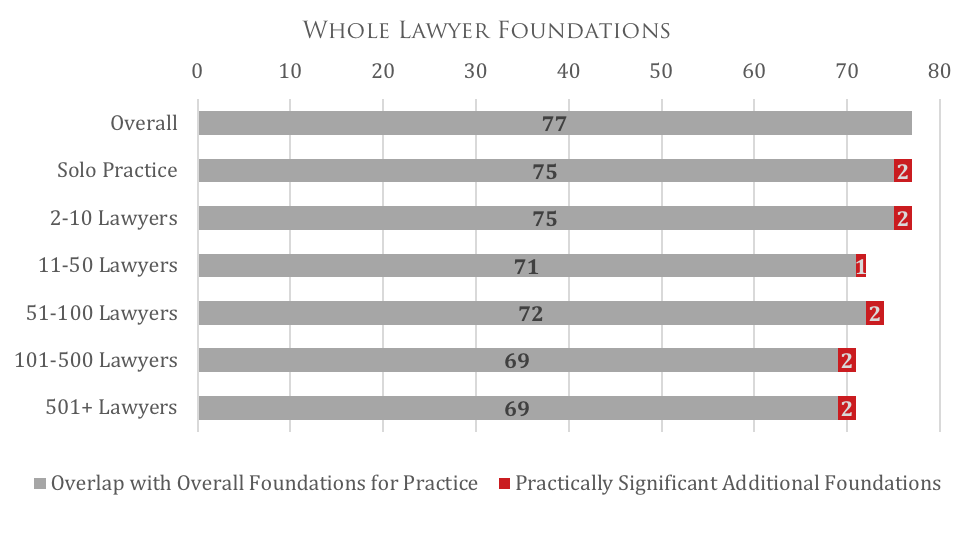The Whole Lawyer: Small Variations among Law Firm Sizes (And Conclusion)
In the last blog, we explained that the 77 foundations survey respondents identified as being necessary for new lawyers in the short term—that is, the foundations that make up the whole lawyer—which IAALS reported in Foundations for Practice: The Whole Lawyer and the Character Quotient, are largely consistent and definitive across respondents. Still, there were a few differences that highlight foundations some practice settings emphasize over others. Similarly, when we focused on private practice, we discovered only slight variations among different law firm sizes. In this blog, we explore the foundations that make up the whole lawyer for each private practice firm size category, and the differences as compared with one another and the whole lawyer overall.
In our study, we grouped the law firm sizes of our respondents into six categories: solo practice and law firms with 2-10, 11-50, 51-100, 101-500, and 501 or more attorneys. When we examined the responses by firm size category, we looked for practically significant differences; that is, variations which (in addition to being statistically significant) represented a difference large enough to influence our thinking in practice.(1)
Respondents Across Law Firm Sizes Identified Few Differences in Desired Foundations for New Lawyers
Because our initial reports focus on the foundations that make up the whole lawyer at the point new lawyers enter the profession, we focus here on differences in foundations considered necessary in the short term. That is, instances where either responses for a particular practice setting warrant categorization as necessary in the short term when it was not categorized as such within the overall results or vice versa.(2) Using this approach, we found that the foundations that constitute the whole lawyer within the six categories of firm size are very similar to the 77 foundations identified in the overall results as the original basis for the whole lawyer:
 There was a general trend toward fewer whole lawyer foundations as firm size increased, with solo and firms with 2-10 lawyers identifying 77 foundations as necessary in the short term and firms with more than 100 lawyers identifying only 71. Still, there was a great deal of overlap in whole lawyer foundations among firm sizes and in comparison with the overall results. And, as was the case with practice settings, even though we found some differences, the foundations that make up the whole lawyer are largely consistent, regardless of firm size. The table below presents the areas of divergence between the whole lawyer for each firm size category compared with the overall whole lawyer.
There was a general trend toward fewer whole lawyer foundations as firm size increased, with solo and firms with 2-10 lawyers identifying 77 foundations as necessary in the short term and firms with more than 100 lawyers identifying only 71. Still, there was a great deal of overlap in whole lawyer foundations among firm sizes and in comparison with the overall results. And, as was the case with practice settings, even though we found some differences, the foundations that make up the whole lawyer are largely consistent, regardless of firm size. The table below presents the areas of divergence between the whole lawyer for each firm size category compared with the overall whole lawyer.
| Firm Size | Foundations Added to the Overall Whole Lawyer | Foundations Removed from the Overall Whole Lawyer |
|---|---|---|
| Solo Practice |
|
|
| 2-10 Lawyers |
|
|
| 11-50 Lawyers |
|
|
| 51-100 Lawyers |
|
|
| 101-500 Lawyers |
|
|
| 500+ Lawyers |
|
|
In the survey, foundations were organized into 15 separate foundation categories.(3) Interestingly, five foundation categories had no practically significant differences affecting the whole lawyer: Communication, Professional Development, Technology and Innovation, Emotional and Interpersonal Intelligence, and Stress and Crisis Management.
Again, the differences we observed across firm sizes are not surprising. For example, respondents from firms with two or more lawyers more frequently valued being visible in the office than did those in solo practice, which is a reasonable expectation in offices where there are many people working at once, often in a team or department-oriented setting. Indeed, solo practitioners emphasized the ability to exercise independent judgment, which is more critical than being visible in the office when working alone. The largest firms (51 or more lawyers) also valued the ability to generate a high quantity of work in new lawyers. These responses may illustrate the current business models of many large firms today, which emphasize to new associates that the amount of billable hours they work is an important metric of their success within the firm. Meanwhile, lawyers in solo practices and in smaller firms with 2-10 lawyers more often valued retaining existing business in new lawyers than all respondents of larger firms. This difference likely reflects the roles that new attorneys occupy in small firms, where they are more likely to develop their own clients and business directly, whereas associates in larger firms begin their practice by supporting more experienced partners who are more likely to be responsible for client relationships.
The foundations that respondents did not consider to be necessary right out of law school also reveal something about how these firms operate. The most obvious illustration of this is that solo practitioner respondents did not think that having a personality that “fits” the firm or organization was necessary right out of law school; again, this likely reflects the nature of working independently as opposed to working in a team setting or alongside a large number of other lawyers and staff. Common to all firm sizes with two or more lawyers was the notion that new lawyers do not need to have mastered interviewing clients and witnesses and seeing a case or project through from start to timely finish. This may reflect that, in these firms, new lawyers are less likely to lead their own cases or deal directly with clients right away, but instead start off by supporting a managing or partner level attorney. This particular dynamic may also explain many of the other differences we observed as firms get larger in size. In larger firms with more than ten lawyers, many respondents did not believe that new lawyers needed to adhere to proper billing practices, possibly because they are not in charge of billing clients. Nor did many respondents from these firms see recognizing client needs, objectives, priorities, constraints, and expectations necessary for new lawyers, which may also be indicative of new lawyers having less direct exposure to clients.
Respondents Across Law Firm Sizes Confirm Importance of Character Quotient
In addition to looking at the results at the foundation level, we looked at the types of foundations that make up the whole lawyer for each practice setting, as compared to one another and the overall whole lawyer. The 147 foundations in the survey fell into one of three categories: legal skills, professional competencies, and characteristics.(4) Nearly half (45%) of all foundations presented in the survey were professional competencies, while the rest were split between legal skills (27%) and characteristics (28%).
 Notably, the breakdown of foundation types when considering the whole lawyer varies from the breakdown of foundation types for all survey items. In fact, both overall and across firm sizes, characteristics make up a disproportionately large percentage of foundations that constitute the whole lawyer (around 40% across the board), while legal skills make up a smaller proportion. As was the case for practice settings and within the overall results, character is very important for new lawyers, across firm sizes.
Notably, the breakdown of foundation types when considering the whole lawyer varies from the breakdown of foundation types for all survey items. In fact, both overall and across firm sizes, characteristics make up a disproportionately large percentage of foundations that constitute the whole lawyer (around 40% across the board), while legal skills make up a smaller proportion. As was the case for practice settings and within the overall results, character is very important for new lawyers, across firm sizes.

Thus, while different firm sizes placed more or less importance on a few foundations, overall the foundations that make up the whole lawyer are consistent and definitive across all firm sizes.
The Whole Lawyer is Constant across All Workplaces
The differences we observed across practice setting and firm size are thought-provoking, particularly to those who study the legal profession and success criteria for lawyers. They have, however, a small practical effect on the key findings in The Whole Lawyer. The 77 foundations identified by respondents as necessary for new graduates are largely the same across all workplaces, which is good news. It gives us a common foundation as we begin to identify the overarching learning outcomes that we can—and should—expect of a legal education.
Endnotes:
1. For a more detailed explanation of what constitutes a practically significant difference, please see our previous blog.
2. For a more detailed explanation of our criteria for categorizing a foundations as necessary in the short term, please see our previous blog.
3. There are three Foundation Types (Legal Skills, Professional Competencies, and Characteristics), and fifteen Foundation categories, which include Business Development and Relations, Communications, Emotional and Interpersonal Intelligence, Involvement and Community Service, Legal Thinking and Application, Litigation Practice, Passion and Ambition, Professional Development, Professionalism, Qualities and Talents, Stress and Crisis Management, Technology and Innovation, Transaction Practice, Working with Others, and Workload Management. For more information, click here and review pages 6-21.
4. “Characteristics” are foundations capturing features or qualities (such as sociability). “Professional competencies” are skills seen as useful across vocations (such as managing meetings effectively). “Legal skills” are those traditionally understood to be required for the specific discipline of law (such as preparing a case on appeal). For more information, click here and review page 22.






